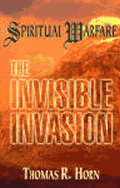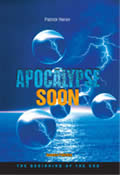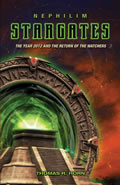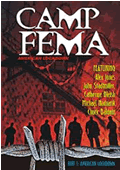PART 16
By Thomas R. Horn
November 5, 2010
NewsWithViews.com
PUTTING THE "HELL" IN THE "HELL SCENARIO"
Beyond
how human augmentation and biological reinvention would spread into the
wider culture following 2012 (the same date former counter-terrorism czar,
Richard Clark, in his book, Breakpoint, predicted serious Grin
rollout), the government report in the last entry (The National Science
Foundation and the United States Department of Commerce report "Converging
Technologies for Improving Human Performance) detailed the especially
 important
global and economic aspects of genetically superior humans acting in superior
ways, offering how, as a result of Grin leading to techno-sapien dna upgrading,
brain-to-brain interaction, human-machine interfaces, personal sensory
device interfaces, and biological war fighting systems, “The twenty-first
century could end in world peace, universal prosperity, and evolution
to a higher level [as] humanity become[s] like a single, transcendent
nervous system, an interconnected ‘brain’ based in new core
pathways of society.” The first version of the government’s
report asserted that the only real roadblock to this “heaven scenario”
would be the “catastrophe” that would be unleashed if society
fails to employ the technological opportunities available to us now. “We
may not have the luxury of delay, because the remarkable economic, political
and even violent turmoil of recent years implies that the world system
is unstable. If we fail to chart the direction of change boldly, we may
become the victims of unpredictable catastrophe.”[1]
This argument parallels what is currently echoed in military corridors,
where sentiments hold that failure to commit resources to develop Grin
as the next step in human and technological evolution will only lead to
others doing so ahead of us and using it for global domination.
important
global and economic aspects of genetically superior humans acting in superior
ways, offering how, as a result of Grin leading to techno-sapien dna upgrading,
brain-to-brain interaction, human-machine interfaces, personal sensory
device interfaces, and biological war fighting systems, “The twenty-first
century could end in world peace, universal prosperity, and evolution
to a higher level [as] humanity become[s] like a single, transcendent
nervous system, an interconnected ‘brain’ based in new core
pathways of society.” The first version of the government’s
report asserted that the only real roadblock to this “heaven scenario”
would be the “catastrophe” that would be unleashed if society
fails to employ the technological opportunities available to us now. “We
may not have the luxury of delay, because the remarkable economic, political
and even violent turmoil of recent years implies that the world system
is unstable. If we fail to chart the direction of change boldly, we may
become the victims of unpredictable catastrophe.”[1]
This argument parallels what is currently echoed in military corridors,
where sentiments hold that failure to commit resources to develop Grin
as the next step in human and technological evolution will only lead to
others doing so ahead of us and using it for global domination.
Not everybody likes the “heaven scenario” imperative, and from the dreamy fantasies of Star Trek to the dismal vision of Aldous Huxley’s Brave New World, some have come to believe there are demons hiding inside transhumanism’s mystical (or mythical?) “Shangri-la.”
“Many of the writers [of the government report cited above] share a faith in technology which borders on religiosity, boasting of miracles once thought to be the province of the Almighty,” write the editors of The New Atlantis: A Journal of Technology and Society. “[But] without any serious reflection about the hazards of technically manipulating our brains and our consciousness...a different sort of catastrophe is nearer at hand. Without honestly and seriously assessing the consequences associated with these powerful new [Grin] technologies, we are certain, in our enthusiasm and fantasy and pride, to rush headlong into disaster.”[2]
Few people would be more qualified than computer scientist Bill Joy to annunciate these dangers, or to outline the “hell scenario” that could unfold as a result of Grin. Yet it must have come as a real surprise to some of those who remembered him as the level-headed Silicon Valley scientist and co-founder of Sun Microsystems (sm) when, as chief scientist for the corporation, he released a vast and now-famous essay, “Why the Future Doesn’t Need Us,” arguing how Grin would threaten in the very near future to obliterate mankind. What was extraordinary about Joy’s prophecy was how he saw himself—and people like him—as responsible for building the very machines that “will enable the construction of the technology that may replace our species.”
“From the very moment I became involved in the creation of new technologies, their ethical dimensions have concerned me,” he begins. But it was not until the autumn of 1998 that he became “anxiously aware of how great are the dangers facing us in the twenty-first century.” Joy dates his “awakening” to a chance meeting with Ray Kurzweil, whom he talked with in a hotel bar during a conference at which they both spoke. Kurzweil was finishing his manuscript for The Age of Spiritual Machines and the powerful descriptions of sentient robots and near-term enhanced humans left Joy taken aback, “especially given Ray’s proven ability to imagine and create the future,” Joy wrote. “I already knew that new technologies like genetic engineering and nanotechnology were giving us the power to remake the world, but a realistic and imminent scenario for intelligent robots surprised me.”
Over the weeks and months following the hotel conversation, Joy puzzled over Kurzweil’s vision of the future until finally it dawned on him that genetic engineering, robotics, artificial intelligence, and nanotechnology posed “a different threat than the technologies that have come before. Specifically, robots, engineered organisms, and nanobots share a dangerous amplifying factor: They can self-replicate. A bomb is blown up only once—but one bot can become many, and quickly get out of control.” The unprecedented threat of self-replication particularly burdened Joy because, as a computer scientist, he thoroughly understood the concept of out-of-control replication or viruses leading to machine systems or computer networks being disabled. Uncontrolled self-replication of nanobots or engineered organisms would run “a much greater risk of substantial damage in the physical world,” Joy concluded before adding his deeper fear:
What
was different in the twentieth century? Certainly, the technologies underlying
the weapons of mass destruction  (wmd)—nuclear,
biological, and chemical (nbc)—were powerful, and the weapons an
enormous threat. But building nuclear weapons required...highly protected
information; biological and chemical weapons programs also tended to require
large-scale activities.
(wmd)—nuclear,
biological, and chemical (nbc)—were powerful, and the weapons an
enormous threat. But building nuclear weapons required...highly protected
information; biological and chemical weapons programs also tended to require
large-scale activities.
The twenty-first-century technologies—genetics, nanotechnology, and robotics...are so powerful that they can spawn whole new classes of accidents and abuses. Most dangerously, for the first time, these accidents and abuses are widely within the reach of individuals or small groups. They will not require large facilities or rare raw materials. Knowledge alone will enable the use of them.
Thus we have the possibility not just of weapons of mass destruction but of knowledge-enabled mass destruction (kmd), this destructiveness hugely amplified by the power of self-replication.
I think it is no exaggeration to say we are on the cusp of the further perfection of extreme evil, an evil whose possibility spreads well beyond that which weapons of mass destruction bequeathed to the nation states, on to a surprising and terrible empowerment.[3]
Joy’s prophecy about self-replicating “extreme evil” as an imminent and enormous transformative power that threatens to rewrite the laws of nature and permanently alter the course of life as we know it was frighteningly revived this year in the creation of Venter’s “self-replicating” Synthia species (Venter’s description). Parasites such as the mycoplasma mycoides that Venter modified to create Synthia can be resistant to antibiotics and acquire and smuggle dna from one species to another, causing a variety of diseases. The dangers represented by Synthia’s self-replicating parasitism has thus refueled Joy’s opus and given experts in the field of counter-terrorism sleepless nights over how extremists could use open-source information to create a Frankenstein version of Synthia in fulfillment of Carl Sagan’s Pale Blue Dot, which Joy quoted as, “the first moment in the history of our planet when any species, by its own voluntary actions, has become a danger to itself.” As a dire example of the possibilities this represents, a genetically modified version of mouse pox was created not long ago that immediately reached 100 percent lethality. If such pathogens were unleashed into population centers, the results would be catastrophic.
This is why Joy and others were hoping a few years ago that a universal moratorium or voluntary relinquishment of Grin developments would be initiated by national laboratories and governments. But the genie is so far out of the bottle today that even college students are attending annual synthetic biology contests (such as the International Genetically Engineered Machine Competition, or igem) where nature-altering witches’ brews are being concocted by the scores, splicing and dicing dna into task-fulfilling living entities. For instance, the igem 2009 winners built “E. chromi”—a programmable version of the bacteria that often leads to food poisoning, Escherichia coli (commonly abbreviated E. coli). A growing list of similar dna sequences are readily available over the Internet, exasperating security experts who see the absence of universal rules for controlling what is increasingly available through information networks as threatening to unleash a “runaway sorcerer’s apprentice” with unavoidable biological fallout.
Venter and his collaborators say they recognize this danger—that self-replicating biological systems like the ones they are building—hold peril as well as hope, and they have joined in calling on Congress to enact laws to attempt to control the flow of information and synthetic “recipes” that could provide lethal new pathogens for terrorists. The problem, as always, is getting all of the governments in the world to voluntarily follow a firm set of ethics or rules. This is wishful thinking at best. It is far more likely the world is racing toward what Joel Garreau was first to call the “hell scenario”—a moment in which human-driven Grin technologies place earth and all its inhabitants on course to self-eradication.
Ironically, some advocates of posthumanity are now using the same threat scenario to advocate for transhumanism as the best way to deal with the inevitable extinction of mankind via Grin. At the global interdisciplinary institute Metanexus (www.metanexus.net/), Mark Walker, assistant professor at New Mexico State University (who holds the Richard L. Hedden of Advanced Philosophical Studies Chair) concludes like Bill Joy that “technological advances mean that there is a high probability that a human-only future will end in extinction.” From this he makes a paradoxical argument:
In a nutshell, the argument is that even though creating posthumans may be a very dangerous social experiment, it is even more dangerous not to attempt it....
I suspect that those who think the transhumanist future is risky often have something like the following reasoning in mind: (1) If we alter human nature then we will be conducting an experiment whose outcome we cannot be sure of. (2) We should not conduct experiments of great magnitude if we do not know the outcome. (3) We do not know the outcome of the transhumanist experiment. (4) So, we ought not to alter human nature.
The problem with the argument is.... Because genetic engineering is already with us, and it has the potential to destroy civilization and create posthumans, we are already entering uncharted waters, so we must experiment. The question is not whether to experiment, but only the residual question of which social experiment will we conduct. Will we try relinquishment? This would be an unparalleled social experiment to eradicate knowledge and technology. Will it be the steady-as-she-goes experiment where for the first time governments, organizations and private citizens will have access to knowledge and technology that (accidently or intentionally) could be turned to civilization ending purposes? Or finally, will it be the transhumanist social experiment where we attempt to make beings brighter and more virtuous to deal with these powerful technologies?
| Subscribe to the NewsWithViews Daily News Alerts! |
I have tried to make at least a prima facie case that transhumanism promises the safest passage through twenty-first-century technologies.[4]
The authors of this book believe the “brighter and more virtuous beings” Professor Walker and others are arguing for possess supernatural elements and that the spirit behind the transhumanist nightmare may put the “hell” in the “hell scenario” sooner than most comprehend.
[Editor's note: This series is based on research contained in Tom and Nita Horn's upcoming new book: Forbidden Gates: How Genetics, Robotics, Artificial Intelligence, Synthetic Biology, Nanotechnology, & Human Enhancement Herald the Dawn of Techno-Dimensional Spiritual Warfare.]
Sign up to be notified when the book on which this series is based is released and receive OVER $60.00 IN FREE GIFTS! Sign up here!
Click here for part -----> 1, 2, 3, 4, 5, 6, 7, 8, 9, 10, 11, 12, 13, 14, 15, 16,
Footnotes:
1,
“Carried
Away with Convergence,” New Atlantis (Summer 2003) 102–105.
2,
Summer
2003 issue of The New Atlantis.
3,
Bill Joy, “Why
the Future Doesn’t Need Us,” Wired (April 2000), emphasis
added
4,
Mark Walker, “Ship
of Fools: Why Transhumanism is the Best Bet to Prevent the Extinction
of Civilization,” Metanexus Institute (2/5/09)
� 2010 Thomas Horn - All Rights Reserved
Sign
Up For Free E-Mail Alerts
E-Mails are used strictly for
NWVs alerts, not for sale
Thomas Horn is the CEO of RaidersNewsNetwork.com and SurvivorMall.com.
Over the last decade, he has authored three books, wrote dozens of published editorials, and had several feature magazine articles. In addition to past articles at NewsWithViews.com , his works have been referred to by writers of the LA Times Syndicate, MSNBC, Christianity Today, Coast to Coast, World Net Daily, White House Correspondents and dozens of newsmagazines and press agencies around the globe. Tom's latest book is "The Ahriman Gate," which fictionalizes the use of biotechnology to resurrect Biblical Nephilim.
Thomas is also a well known radio personality who has guest-hosted and appeared on dozens of radio and television shows over the last 30 years, including "The 700 Club" and "Coast to Coast AM." When looking for a spokesperson to promote their film "Deceived" staring Louis Gossett Jr. and Judd Nelson, "Cloud 10 Pictures" selected Thomas as their spokesperson to explain the Christian viewpoint on UFO-related demonology.
Web Site: RaidersNewsNetwork.com
E-Mail: RaidersNewsUpdate@gmail.com













 Share
This Article
Share
This Article








